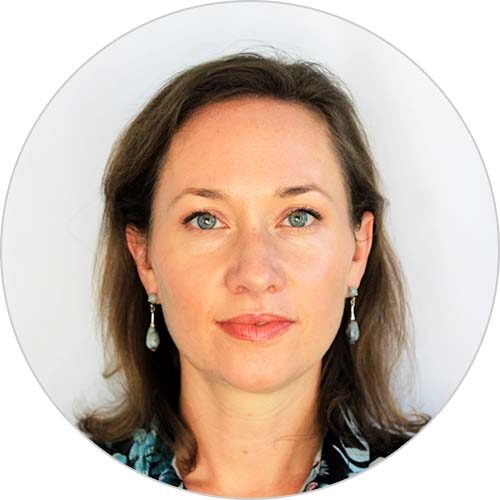
Our People .

Global Practice Lead, Health Rachel Deussom
Rachel Deussom is the director of the Chemonics Global Health Practice, with over 17 years of experience focusing on health systems strengthening, human resources for health, community health, digital Health, HIV/AIDS, and maternal and child health. Previously, she acted as the technical director of HRH2030 Program, USAID’s global health workforce flagship project, led by Chemonics. Rachel has managed teams and provided technical and/or operations support across Africa and Asia, contributing to USAID, World Bank, and Gates-funded initiatives. She has developed tools and conducted interventions for human resources for health strengthening in the areas of pre-service education, retention, productivity and performance, community engagement, supply chain management, gender, and sustainable financing. She also held an adjunct faculty position at George Washington University and is a trained doula. Rachel has a B.A. in French from Georgetown University and an M.S. in public health from the Harvard T.H. Chan School of Public Health.
by Rachel Deussom
Making The Most of It: Optimizing Human Resources for Health for Family Planning
Human resources for health (HRH) refer to the diverse collective of health workers that drive, manage, and lead health systems. They are doctors, nurses, midwives, community health workers (CHWs), and social workers, but also pharmacists, shop owners, health managers, and educators. This workforce provides health services in various settings, such as hospitals, clinics, offices, virtual…
Recommendations for a Diverse, Sustained Health Workforce
There are simply not enough health workers to meet the basic health needs of all people worldwide. This prevents development practitioners from contributing to higher-performing health systems, as we struggle to make the most with the health professionals we have available, who are often concentrated in urban areas, working in professional silos, and failing to…
What Do Women Want? Clean Toilets in Healthcare Facilities
White Ribbon Alliance launched the global What Women Want campaign in 2018. The alliance asked 1.2 million women and girls from 114 countries, “What is your one request for quality reproductive and maternal healthcare services?” Their answers surprised many. Second only to respectful and dignified care, women asked for improved access to water, sanitation, and…
“Imagine All the People” Living Healthy Lives: Personal Reflections on Themes from HSR2018
Last month was a magnificent culmination of events for us global health dreamers, with the Fifth Global Symposium on Health Systems Research (HSR2018) taking place in Liverpool, United Kingdom, the birthplace of the Beatles. Raised on my parents’ Fab Four vinyls, I walked along the River Mersey with John Lennon’s lyrics in my head. The…
International Day of the Midwife: Promoting Diversity to Reduce Disparities in Maternal Health
A recent article highlighted the staggering disparities that persist in maternal and neonatal outcomes in America. The disparities are in part because of societal and racial bias within the health-care system. In New York, black women are four times more likely than white women to die in childbirth. Pre-eclampsia and eclampsia are life-threatening pregnancy-related conditions that are sixty percent more…
Our 2030 Vision for the Health Workforce
This post originally appeared on the Frontline Health Workers Coalition’s blog. Teenager Durah stretches under a lamp with a book, absorbing every word and figure. Inspired by her aunt, she wants to become a nurse. She is the future health workforce. She is who the world needs tomorrow. Durah wants flexibility, occupational safety, and career opportunities.…
Human Resources for Health (HRH): Principles and Practices
This course, authored by Rachel Deussom and Hayley Robinett of Chemonics, orients learners to the basic principles and promising practices related to health workforce development and strengthening.
Using Mobile Technology to Address the ‘Three Delays' to Reduce Maternal Mortality in Zanzibar
This piece, authored by Rachel Deussom, Marc Mitchell, Boston, MA, USA) and Julia Dae Ruben, demonstrates the effectiveness of mobile technology in addressing childbirth's three delays and its potential to impact maternal mortality in low-income countries.
A conceptual framework for measuring community health workforce performance within primary health care systems
This paper details a framework, list of indicators, and measurement considerations for monitoring CHW performance in low- and middle-income countries.
Systematic review of performance-enhancing health worker supervision approaches in low- and middle-income countries
This paper is a systematic review of studies documenting supervision enhancements and approaches that improved health worker performance to highlight components associated with these interventions’ effectiveness. Structured by a conceptual framework to classify the inputs, processes, and results, the review assessed 57 supervision studies since 2010 in approximately 29 LMICs.
Putting health workers at the centre of health system investments in COVID-19 and beyond
This paper explores applying the Health Worker Life Cycle Approach, which provides a useful conceptual framework that adapts a health labour market approach to outline key areas and recommendations for health workforce investment—building, managing and optimising—to systematically meet the needs of health workers and the systems they support. It also emphasises the importance of protecting the workforce as a cross-cutting investment, which is especially important in a health crisis like COVID-19.
USAID Flagship CHW Resource Package
The United States Agency for International Development (USAID) Flagship Community Health Worker (CHW) Resource Package compiles priority resources for strengthening CHW programs developed through USAID’s Bureau for Global Health (BGH) investments, as well as what USAID BGH’s flagship partners have produced and prioritized. It includes tools, research, guides, approaches, and best practices recommended by USAID’s flagship project community health experts through a series of convenings and reviews. The rationale for the development of this package was to showcase these priority resources for greater internal and external dissemination and agenda setting, including the Community Roadmap and the WHO CHW Hub. It is a living document, and we expect to update it periodically as emergent state-of-the-art resources are recommended by flagship experts.


